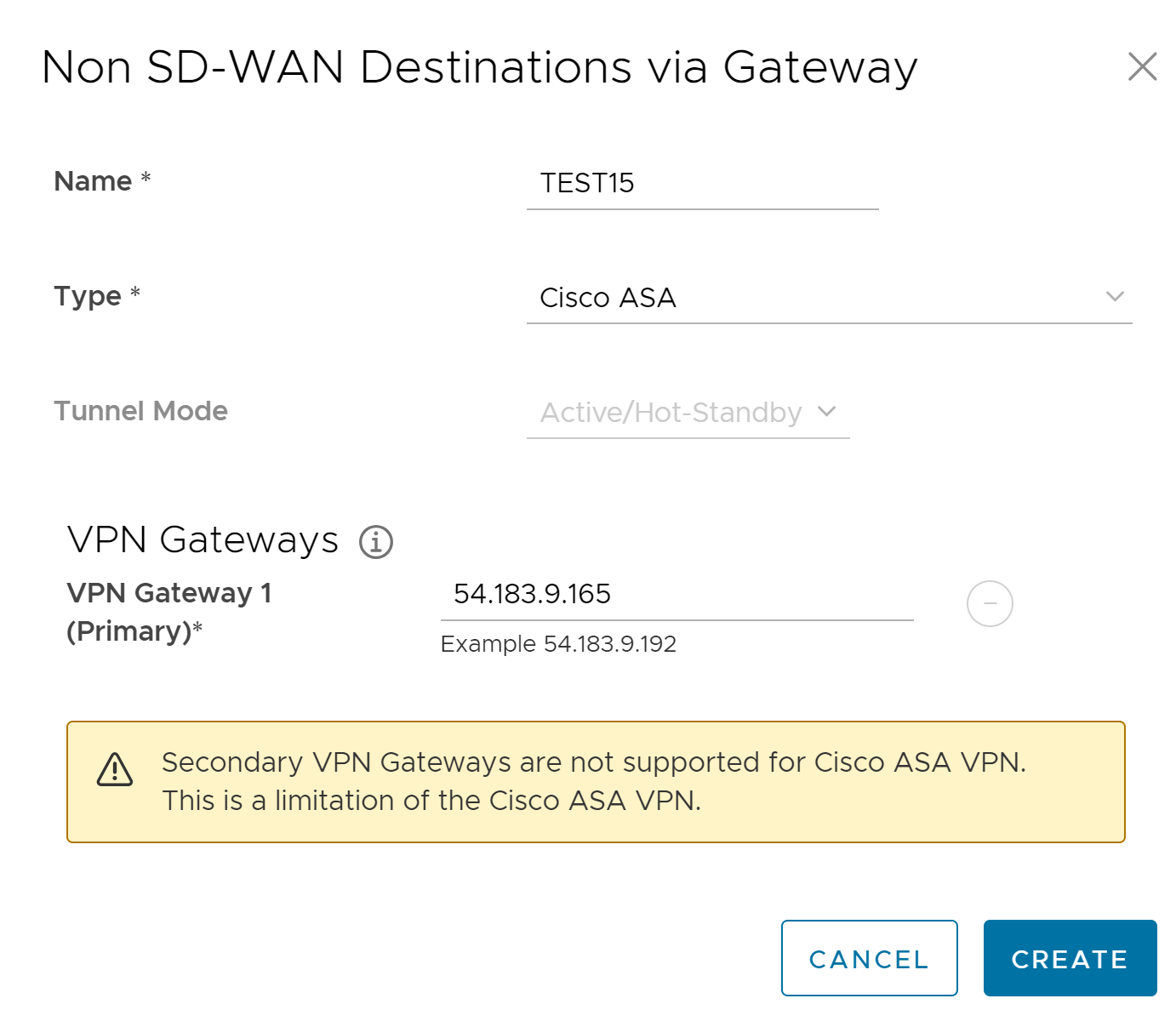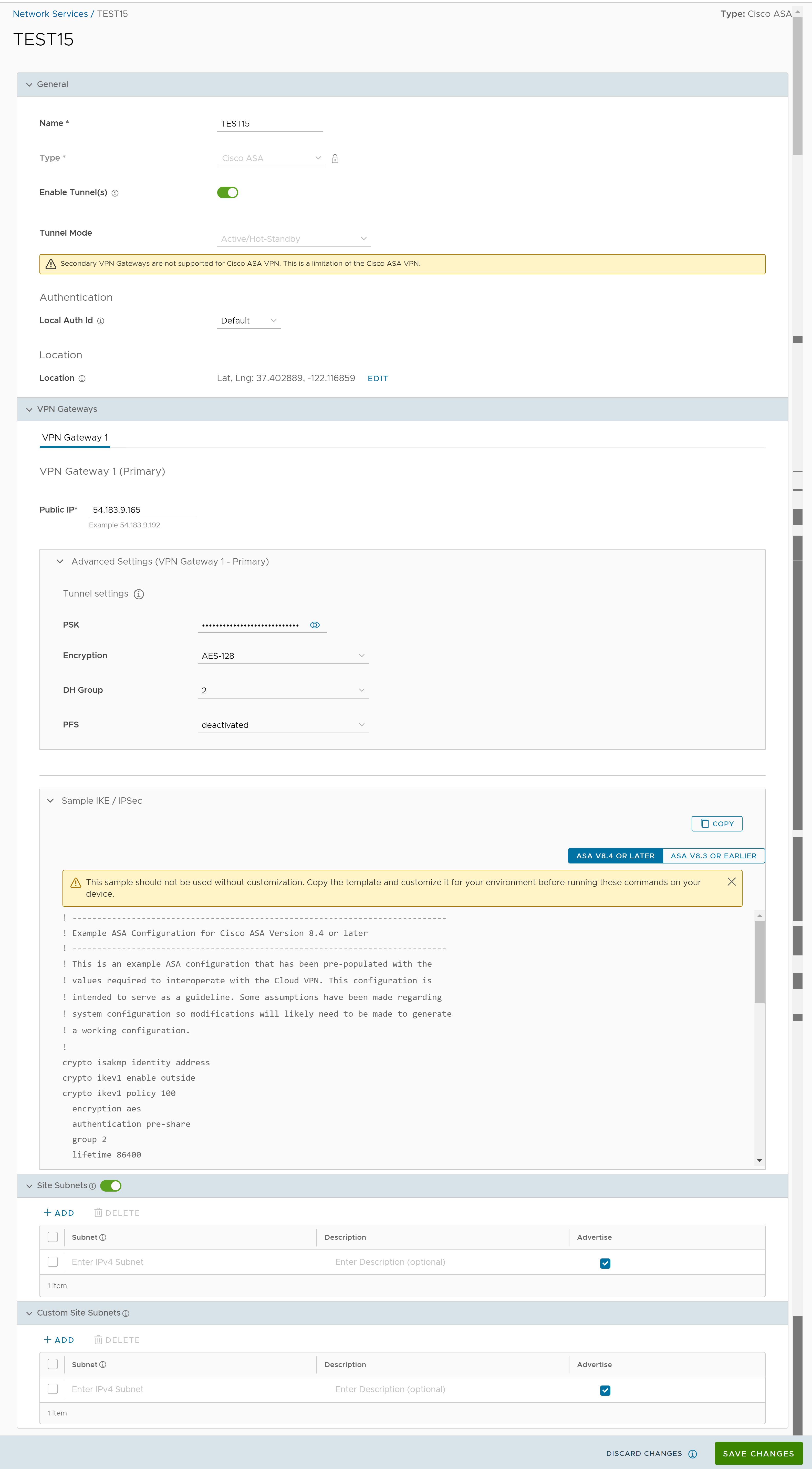Follow the below steps to configure a Non SD-WAN Destination of type Cisco ASA in the SASE Orchestrator.
Procedure
- Once you have created a Non SD-WAN Destination configuration of the type Cisco ASA, you are redirected to an additional configuration options page:

 Note: Secondary VPN Gateway is not supported for the Cisco ASA service type.
Note: Secondary VPN Gateway is not supported for the Cisco ASA service type. - You can configure the following tunnel settings:
Option Description General Name You can edit the previously entered name for the Non SD-WAN Destination. Type Displays the type as Cisco ASA. You cannot edit this option. Enable Tunnel(s) Click the toggle button to initiate the tunnel(s) from the SD-WAN Gateway to the Cisco ASA VPN Gateway. Tunnel Mode Active/ Hot-Standby mode supports to set up a maximum of 2 tunnel endpoints or Gateways. Active/Active mode supports to set up a maximum of 4 tunnel endpoints or Gateways. All Active tunnel can send and receive traffic through ECMP. VPN Gateway 1 Enter a valid IP address. Public IP Displays the IP address of the Primary VPN Gateway. PSK The Pre-Shared Key (PSK) is the security key for authentication across the tunnel. The SASE Orchestrator generates a PSK by default. If you want to use your own PSK or password, enter it in the text box. Encryption Select either AES-128 or AES-256 as the AES algorithm key size to encrypt data. The default value is AES-128. DH Group Select the Diffie-Hellman (DH) Group algorithm from the drop-down menu. This is used for generating keying material. The DH Group sets the strength of the algorithm in bits. The supported DH Groups are 2, 5, and 14. The default value is 2. PFS Select the Perfect Forward Secrecy (PFS) level for additional security. The supported PFS levels are deactivated, 2, and 5. The default value is deactivated. Local Auth Id Local authentication ID defines the format and identification of the local gateway. From the drop-down menu, choose from the following types and enter a value: - FQDN - The Fully Qualified Domain Name or hostname. For example: vmware.com
- User FQDN - The User Fully Qualified Domain Name in the form of email address. For example: [email protected]
- IPv4 - The IP address used to communicate with the local gateway.
- IPv6 - The IP address used to communicate with the local gateway.
Note:- If you do not specify a value, Default is used as the local authentication ID.
- For Cisco ASA Non SD-WAN Destination, the default local authentication ID value used is the Local IP address of the SD-WAN Gateway.
Sample IKE / IPsec Click to view the information needed to configure the Non SD-WAN Destination Gateway. The Gateway administrator should use this information to configure the Gateway VPN tunnel(s). Location Click Edit to set the location for the configured Non SD-WAN Destination. The latitude and longitude details are used to determine the best Edge or Gateway to connect to in the network. Site Subnets Use the toggle button to activate or deactivate the Site Subnets. Click Add to add subnets for the Non SD-WAN Destination. If you do not need subnets for the site, select the subnet and click Delete. Note: To support the datacenter type of Non SD-WAN Destination, besides the IPsec connection, you must configure Non SD-WAN Destination local subnets into the VMware system.Custom Site Subnets Use this section to override the source subnets routed to this VPN device. Normally, source subnets are derived from the Edge LAN subnets routed to this device. - Click Save Changes.